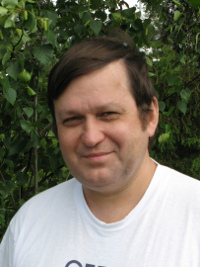 Jouko Ritakari (Photo credit: Metsähovi Radio Observatory)
Jouko Ritakari (Photo credit: Metsähovi Radio Observatory)
Jouko Ritakari
Contributed by Ari Mujunen and Merja Tornikoski
Jouko Ritakari was born in Savonranta (Finland) on 15 June 1956. He received his Master's degree in Electrical Engineering from Helsinki University of Technology in 1980, and a few years later, a Master's degree in Economics from Helsinki School of Economics. He started his career pioneering local area networks in banking applications at Nokia Corporation in 1979--1982 and then moved on to Technical Research Centre of Finland to design one of the first campus-wide networks for the Otaniemi university and research campus in 1984--1986.
In 1987 Jouko had already established his own telecommunications consulting business and he was searching for more challenging endeavours among the research community. Helsinki University of Technology Metsähovi Radio Observatory had initiated a project to start Very Long Baseline Interferometry observations and Jouko was hired there as a part-time engineer to help in acquiring the necessary equipment for VLBI. The project experienced a major setback when Finnish Academy of Sciences granted only half of the required money to purchase a VLBA Data Acquisition Rack, which prompted Jouko to promise to build a VLBA DAR from components with the reduced budget. This experience was instrumental later on when Jouko devoted much of his time to developing new ideas to improve the VLBI data acquisition process and equipment.
In another project at Metsähovi in 1997--1998, Jouko designed a High-Rate Data Link data acquisition and archival system for Alpha Magnetic Spectrometer (AMS-1) during the Space Shuttle flight STS-91 (a collaboration with NASA, CERN, ETHZ, and MIT, led by the Physics Nobel laureate Prof. Samuel Ting). The system was completely COTS-based (except for one simple input interface board) and its success certainly influenced much of Jouko's perception of what commercial off-the-shelf equipment can do if given a chance.
It is fair to say that Jouko devoted the rest of his career to commoditising VLBI data acquisition. In 2002 he designed a VSI interface board which allowed 512 Mbit/s of VLBI data to flow into a typical commodity PC. Instead of focusing on hard disk recording with such commodity computers, Jouko was much more interested in using global networks to directly transfer VLBI data, and he demonstrated this already in 2003 at 1 Gbit/s and 2 Gbit/s on transcontinental links (Finland--Japan). These developments with UDP-based protocols such as Tsunami culminated in 2008 in a demonstration of real-time transfer of sampled telescope radio signal at a record-breaking rate of 8 gigabits per second over the common Internet. Later, Jouko contributed greatly to the development of software VLBI correlators on standard data center computers as well as to the FlexBuff VLBI data recorder concept which uses unmodified general-purpose disk servers as its hardware platform.
One of Jouko's great strengths was his ability to recognise the "winning" technologies of the future, and how they could be deployed to solve problems. This often put him at the forefront of thinking among his colleagues. This ability to see what was coming combined with his outspoken manner in presenting his opinions, sometimes created controversy and opposition which Jouko himself found hard to understand.
Jouko passed away on 3 May 2013, only a few weeks before his 57th birthday. All of us who had the pleasure of knowing him personally miss him and his unique personality—playful and warm-hearted.
Modified on Monday, 14-Feb-2022 12:12:54 EST by Ellen Bouton, Archivist (Questions or feedback)
|
![[IAU logo]](iau_wb_thumb.jpg)
![[URSI logo]](URSI-logo-thumb.jpg)
![[Karl Jansky at his antenna]](jansky_photo_02_thumb.jpg)
![[Reber's Wheaton antenna]](Reber_Telescope_Wheaton_thumb.jpg)
![[Dover Heights]](Dover_Heights_02_thumb.jpg)
![[4C telescope]](GB61-195_4C_telescope_thumb.jpg)
![[Ewen and horn antenna]](ewen_horn1s.jpg)
![[Dwingeloo, 1956]](Dwingeloo-1956-thumb.jpg)
![[Jocelyn Bell Burnell and Cambridge antenna used in pulsar discovery]](burnell2_thumb.jpg)
![[Lovell Telescope at Jodrell Bank]](site_1594_0001-500-334-20180316163019-thumb150.jpg)
![[Wilson, Penzias, and Bell Labs horn antenna]](wilson-penzias-horn_thumb.jpg)
![[6-m Millimeter Radio Telescope in Mitaka, Japan]](6m-thumb.jpg)

